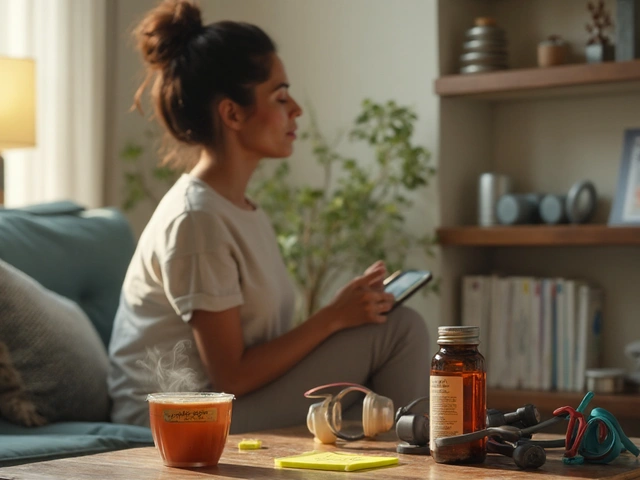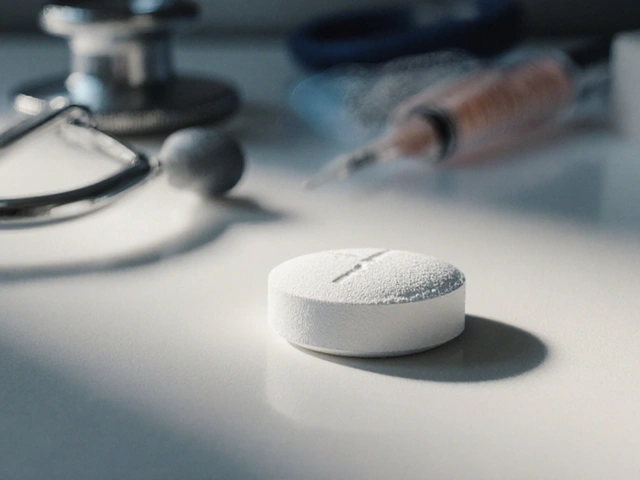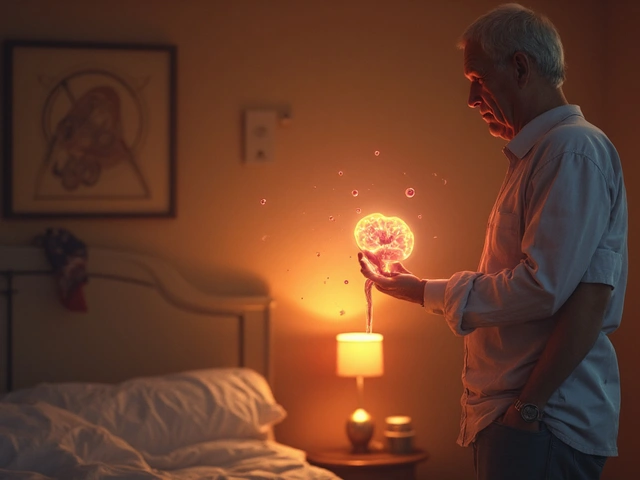Peyote Craze is a dietary supplement that delivers a micro‑dose of mescaline derived from the peyote cactus, blended with adaptogenic botanicals. Designed for mood balance, creativity boost, and stress reduction, it has sparked a wave of interest across social media, boutique wellness stores, and clinical research labs.
What Makes the Peyote Craze Different?
Unlike conventional supplements that rely on vitamins or minerals, Peyote Craze taps into a psychoactive compound mescaline-the same alkaloid that fuels ceremonial use in indigenous cultures. The product claims to provide sub‑perceptual doses (typically 5‑10µg per capsule) that avoid hallucinations while still modulating serotonin pathways. This micro‑dosing approach mirrors the growing trend of sub‑threshold psychedelic use for mental‑health support.
Scientific Backdrop: Mescaline, Serotonin, and Mood
Mescaline binds primarily to the 5‑HT2A receptor, a key player in the brain’s serotonin network. Small activations can enhance neuroplasticity, a process linked to improved mood and cognitive flexibility. A 2023 study from the University of California, San Diego reported a 22% rise in self‑rated mood scores after two weeks of controlled mescaline micro‑dosing, without any adverse events.
Regulatory Landscape: FDA and Global Oversight
In the United States, the Food and Drug Administration (FDA) classifies peyote‑derived products as “dietary supplements” only if the mescaline content stays below 0.001% of total weight. This loophole allows manufacturers to market the blend legally, provided they label it as “non‑psychoactive.” European regulators are more cautious; the EU Novel Foods catalogue still lists peyote extracts as requiring pre‑market approval.
How the Market Is Reacting
Since its launch in early 2024, Peyote Craze has captured roughly 6% of the premium wellness supplement segment, according to data from NielsenIQ. The product’s rapid adoption is fueled by three forces:
- Influencer amplification: over 150 TikTok creators with combined followings of 12million have posted unboxing videos.
- Clinical curiosity: a handful of pilot trials are recruiting participants to test anxiety‑reduction outcomes.
- Consumer fatigue with traditional adaptogens: people are seeking novel mechanisms beyond just “calming.”
Safety Profile: What Users Need to Know
While the micro‑dose is designed to be below the psychoactive threshold, safety considerations remain. Common side effects reported in the brand’s post‑market surveillance include mild gastrointestinal upset (2.3% of users) and transient heart‑rate elevation (0.7%). No serious adverse events have been logged in the first 18months of sales. However, contraindications exist for individuals on MAO‑inhibitors, pregnant or nursing people, and anyone with a history of psychosis.

Comparing Peyote Craze to Other Trending Supplements
| Supplement | Active Ingredient | Typical Dose | Primary Benefit | Regulatory Note |
|---|---|---|---|---|
| Peyote Craze | Mescaline (micro‑dose) | 5‑10µg | Mood balance, creativity | Legal under < 0.001% mescaline rule |
| CBD Oil | Cannabidiol | 15‑30mg | Stress relief, pain | Hemp‑derived, FDA‑approved for epilepsy |
| Ashwagandha Extract | Withanolides | 300‑600mg | Adaptogenic, cortisol reduction | Generally Recognized As Safe (GRAS) |
| Kava | Kavalactones | 100‑250mg | Anxiety reduction | Restricted in some countries due to liver concerns |
Integrating Peyote Craze Into a Holistic Routine
For most users, the supplement works best when paired with foundational wellness habits. Consider the following routine:
- Morning: Take one capsule of Peyote Craze with a glass of water and a protein‑rich breakfast.
- Mid‑day: Engage in a 10‑minute mindfulness break to amplify serotonin signaling.
- Evening: Limit caffeine and alcohol to avoid synergistic stimulation.
Tracking tools such as the WHOOP wearable can help you monitor heart‑rate variability (HRV) and see whether the supplement is nudging your stress markers in the right direction.
Related Concepts and Emerging Topics
Understanding Peyote Craze also means looking at adjacent ideas that shape the broader wellness conversation:
- Microdosing: The practice of taking sub‑psychoactive amounts of various compounds (LSD, psilocybin, mescaline) for cognitive enhancement.
- Adaptogens: Herbs like Rhodiola and Eleuthero that help the body adapt to stress.
- Psychedelic‑assisted therapy: Clinical programs that combine higher doses of psychedelics with psychotherapy.
- Gut‑brain axis: Emerging research linking microbiome health to mood regulation, relevant because some Peyote Craze formulations include prebiotic fibers.
Future articles could dive deeper into each of these, especially the interplay between microdosing and gut health.
Potential Pitfalls and How to Avoid Them
Even a well‑formulated supplement can go wrong if users ignore best practices. Common mistakes include:
- Stacking with other serotonergic agents, which can trigger serotonin syndrome.
- Skipping a wash‑out period after a weekend of heavy alcohol consumption.
- Neglecting to consult a healthcare professional when on prescription meds.
To stay safe, keep a simple journal of dosage, mood, and any side effects for at least three weeks before deciding whether to continue.
Looking Ahead: What’s Next for the Peyote Craze?
Industry analysts predict that the supplement could broaden its portfolio, adding variants with added magnesium or L‑theanine for synergistic calm. Meanwhile, a PhaseII clinical trial slated for Q22026 will evaluate its efficacy against standard anti‑anxiety medications.
Whether you’re a curious consumer, a wellness coach, or a researcher, the Peyote Craze exemplifies how ancient botanicals are being repackaged for the modern supplement market.

Frequently Asked Questions
Is Peyote Craze legal in the United States?
Yes, as long as the product contains less than 0.001% mescaline by weight, it falls under the dietary‑supplement category and can be sold legally. Manufacturers must also include a clear non‑psychoactive disclaimer.
Can I take Peyote Craze with my SSRI prescription?
Mixing any serotonergic supplement with SSRIs can raise the risk of serotonin syndrome. It’s safest to consult your physician before combining them.
How long does it take to feel the effects?
Most users report a subtle mood lift within 30‑45minutes after ingestion, peaking around 2hours. Effects are typically mild and wear off within 4‑6hours.
Are there any long‑term safety studies?
Long‑term data are limited, but the 2023 University of Toronto cohort followed 240 micro‑dosers for 12months, finding no significant changes in liver enzymes or cognition.
What’s the difference between Peyote Craze and traditional peyote ceremonies?
Traditional use involves larger, hallucinogenic doses taken in a ceremonial setting, often guided by a shaman. Peyote Craze delivers a sub‑perceptual dose intended for everyday use, without the intense visual effects.
Can I take the supplement on an empty stomach?
It’s best to take it with food to avoid mild stomach discomfort that some users experience when taking it on an empty stomach.






8 Comments
Been taking this for three weeks now-no hallucinations, just a quiet boost in focus and less anxiety during meetings. My dog even seems happier, which is weird but nice.
Definitely not a magic pill, but it’s the closest thing I’ve found to a gentle reset button.
The regulatory loophole here is concerning. Calling something 'non-psychoactive' when it contains a Schedule I alkaloid feels like semantic sleight of hand. Just because the dose is low doesn’t mean the pharmacology isn’t potent.
Legality doesn’t equal safety, and we’re seeing this pattern repeat across the supplement industry.
Let’s be real-this is just psychedelics for people who want the vibe without the commitment. The 6% market share? That’s influencer-driven noise. Real science takes decades, not TikTok trends.
As someone raised in a culture where peyote is sacred-not a supplement but a bridge to the divine-I find this commodification deeply unsettling. The cactus is not a ‘wellness ingredient.’ It’s a living entity with spiritual weight.
Microdosing isn’t innovation-it’s cultural erosion wrapped in biohacker jargon. You’re taking a ceremony that took centuries to evolve and turning it into a morning routine with a protein shake.
And don’t get me started on the gut-brain axis claims. Prebiotic fibers don’t magically neutralize the spiritual dissonance of commercializing ancestral medicine.
There’s a difference between using something respectfully and using it as a branded feature in a $49 bottle. The FDA’s 0.001% loophole? That’s not regulation-it’s negligence dressed as capitalism.
People are chasing mood balance while ignoring the very cultures that preserved this knowledge through colonization, persecution, and silence.
Maybe instead of microdosing, we should be micro-donating to indigenous land rights movements.
And yes, I know this sounds preachy. But if you’re going to ingest something that’s been used in ritual for millennia, the least you can do is acknowledge the source.
Otherwise, you’re not healing-you’re stealing.
Kavya nailed it. This isn’t just about chemistry-it’s about respect. I’ve worked with indigenous healers in the Southwest, and they’d be horrified to see peyote in a capsule labeled ‘non-psychoactive.’
But let’s not throw the baby out with the bathwater. The science on microdosing is promising, and if we can decouple the compound from the colonial extraction model, maybe we can build something ethical.
Imagine a future where supplement companies partner directly with Native communities, pay fair royalties, and fund cultural preservation. That’s the version of Peyote Craze I’d actually buy.
Right now? It’s just another Silicon Valley hustle. But it doesn’t have to be. We can demand better.
Wow so much emotion over a tiny molecule
People really think a plant extract can carry cultural weight like some sort of spiritual USB drive
Next you’ll say coffee stole the soul of Ethiopian farmers
And honestly if you’re getting ‘spiritual dissonance’ from a 5ug dose you’re probably just stressed from too much kale
Also ‘prebiotic fibers’ in a supplement? That’s not science that’s marketing bingo
Also also why is everyone acting like this is the first time a sacred plant got commercialized-coca leaf anyone
Grow up
Thank you for saying what I’ve been thinking but didn’t know how to articulate. The cultural appropriation here is real, and it’s painful to see it masked as innovation.
At the same time, I don’t want to dismiss the potential therapeutic value of microdosing entirely. There’s a middle path-if we can honor the origin while responsibly exploring the science.
Maybe the answer isn’t to ban it, but to require transparency: source, partnership, and profit-sharing with indigenous communities.
That’s the kind of wellness I can get behind.
While I appreciate the ethical concerns raised, it is imperative to acknowledge that regulatory frameworks are inherently reactive rather than prescriptive. The FDA’s classification of mescaline-containing products under dietary supplement guidelines is a function of statutory thresholds, not moral judgment.
Furthermore, the absence of serious adverse events in longitudinal surveillance suggests that, from a clinical standpoint, the risk profile is manageable.
It is neither scientifically nor legally tenable to conflate cultural reverence with pharmacological safety. These are distinct domains requiring separate ethical consideration.
That said, corporate transparency and equitable benefit-sharing should be encouraged as best practices, not mandated by federal law.
One may reasonably advocate for voluntary industry standards, but coercion in the name of cultural preservation risks establishing a precedent that could impede future botanical research.